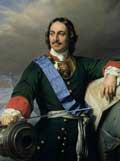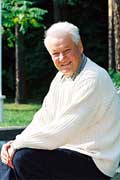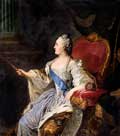A VERY BRIEF HISTORY OF RUSSIA
We may be biting off more than we can chew by including a history of Russia} but who has time to read several thousand pages in scholarly books? This little bit should give you enough background to make the sights you see come alive.


9th century According to early chronicles, the Vikings from Scandinavia establish a settlement in the Upper Volga region. Norseman Rurik, a Scandinavian chief, assumes control of Eastern Slavic lands around Novgorod. The Rurik dynasty continues until 1598. Rurik’s relative, Olga, conquers Kiev, Kiev and Novgorod are united as the state of Kievan Rus.
 10th century Vladimir I introduces feudalism, converts to Orthodox Christianity and makes Orthodoxy the official religion of Kievan Rus. Novgorod brakes off from Kiev and the empire is divided.
10th century Vladimir I introduces feudalism, converts to Orthodox Christianity and makes Orthodoxy the official religion of Kievan Rus. Novgorod brakes off from Kiev and the empire is divided.

11th century Yaroslav the Wise rules from Kiev in the Golden Age of Rus. The first Russian Metropolitan is appointed, symbolizing the church’s growing independence from Constantinople. Novgorod remains a powerful center of mercantilism and religion.
 12th century Benevolent ruler Vladimir II Monomakh unites the empire briefly. He founds the city of Vladimir, allowing his son, Yury Dolgoruky to rule there. ‘Long-armed’ Yury, as he was known, eventually splits from Novgorod and founds the city of Moscow. His son, Andrey Bogolubsky, sacks Kiev and moves the capital of Rus to Vladimir.
12th century Benevolent ruler Vladimir II Monomakh unites the empire briefly. He founds the city of Vladimir, allowing his son, Yury Dolgoruky to rule there. ‘Long-armed’ Yury, as he was known, eventually splits from Novgorod and founds the city of Moscow. His son, Andrey Bogolubsky, sacks Kiev and moves the capital of Rus to Vladimir.
 13th century Mongols led by Genghis Khan thunder out of Asia, invade the Caucasus and the Volga and Don plains, sack Kiev, and Russia becomes a part of the Golden Horde, a Tatar Khanate virtually independent ofthe Mongol Empire. They continue to trounce Russian princedoms until Genghis dies. His grandson, Batu Khan, finishes the job, laying waste to every town from Kiev to Moscow.
13th century Mongols led by Genghis Khan thunder out of Asia, invade the Caucasus and the Volga and Don plains, sack Kiev, and Russia becomes a part of the Golden Horde, a Tatar Khanate virtually independent ofthe Mongol Empire. They continue to trounce Russian princedoms until Genghis dies. His grandson, Batu Khan, finishes the job, laying waste to every town from Kiev to Moscow.
The Golden Horde rules the Russian principalities until the 15th century from present day Volgograd. Prince Alexander defeats invading Swedes, and the Golden Horde installs him as Grand Prince ofRus. His son Danil is made Prince of Muscovy. The Church moves to Vladimir. (Khan translates into “king”).
 14th century The seat of the empire is moved once again, to Muscovy. Ivan I is installed as Grand Prince. Ivan is known as ‘Moneybags’ due to his energetic tax-collecting and embezzling.
14th century The seat of the empire is moved once again, to Muscovy. Ivan I is installed as Grand Prince. Ivan is known as ‘Moneybags’ due to his energetic tax-collecting and embezzling.
Later in the century, Grand Prince Dmitry attacks what is left of the Golden Horde and wins a historic battle on the Don River. The Mongols however, attack back and enslave one million Russians. The Church moves to Moscow.
 15th century Under Vassily T and Vassily II, Moscow continues to resist the Mongol-Tatar domination but not successfully, until the arrival of Ivan III (the Great) who refuses to pay tribute to the Golden Horde and ends 200 years of SUbjugation. Ivan annexes major principalities from Novgorod to the Urals and Russia is more or less unified and five times greater than before. Russian Church becomes fully independent of Constantinople. Moscow becomes the most powerful Russian city and is regarded as the Third Rome. Famous Moscow Kremlin is built.
15th century Under Vassily T and Vassily II, Moscow continues to resist the Mongol-Tatar domination but not successfully, until the arrival of Ivan III (the Great) who refuses to pay tribute to the Golden Horde and ends 200 years of SUbjugation. Ivan annexes major principalities from Novgorod to the Urals and Russia is more or less unified and five times greater than before. Russian Church becomes fully independent of Constantinople. Moscow becomes the most powerful Russian city and is regarded as the Third Rome. Famous Moscow Kremlin is built.
 16th century Ivan IV is crowned tsar. He expands Russia ‘s territory conquering the Tatar strongholds of Kazan and Astrakhan, thereby gaining access to the Caspian Sea and Siberia. He isn’t able to claim the Baltic countries even though he tries. His despotic rule earns him the nickname Ivan the Terrible. A rather paranoid and violent man, Ivan kills his son in a fit of rage.
16th century Ivan IV is crowned tsar. He expands Russia ‘s territory conquering the Tatar strongholds of Kazan and Astrakhan, thereby gaining access to the Caspian Sea and Siberia. He isn’t able to claim the Baltic countries even though he tries. His despotic rule earns him the nickname Ivan the Terrible. A rather paranoid and violent man, Ivan kills his son in a fit of rage.
Ivan is succeeded by his second son, the dimwitted Fyodor, who is controlled by his brother-inlaw, Boris Godunov as Regent. Boris plots the murder of Fyodor’s brother, Tsarevitch Dmitry, in Uglich. Fyodor’s death marks the end of the Rurik dynasty. Boris Godunov takes the throne.
 17th century Widespread famine and peasant uprisings usher in this century called The Time of Troubles. In 1604, a Russian monk named Gregory living in Poland claims to be Tsarevitch Dmitry, killed in Uglich. Discontented boyars back the pretender who marches to Moscow. Gregory kills Boris Godunov’s son who is reigning and proclaims himself tsar. He is known as False Dmitry I and rules for a year before being killed by a loyalist army led by Vassily Shuisky.
17th century Widespread famine and peasant uprisings usher in this century called The Time of Troubles. In 1604, a Russian monk named Gregory living in Poland claims to be Tsarevitch Dmitry, killed in Uglich. Discontented boyars back the pretender who marches to Moscow. Gregory kills Boris Godunov’s son who is reigning and proclaims himself tsar. He is known as False Dmitry I and rules for a year before being killed by a loyalist army led by Vassily Shuisky.
![]()
Another False Dmitry appears, and the Polish army takes advantage of the confusion by occupying Moscow, but they are eventually ousted by a voluntary army. A young boyar named Michael Romanov is chosen to take the throne , ending the Time of Troubles and beginning more than 300 years of Romanov rule of Russia.
Michael’s successor Alexey makes large territorial gains including Ukraine and Siberia. He turns serfs into slaves. Cossack Stepan Razin leads the country’s largest ever peasant revolt, which is ultimately subdued. In 1689, Peter I (later known as Peter the Great) seizes power from his sister-regent, and begins transforming Russia into a world power.
 18th century Peter the Great increases ties with Europe, founds the new capital city of St. Petersburg (named after the saint, not himself) and moves the capital from Moscow. The new city flourishes as the political and cultural center of Russia for 200 years. Peter force-feeds European culture to Russia, and in an attempt to modernize the country fosters unprecedented advances but also resentment. The country’s first navy defeats the Swedes in the Northern War, gaining the Baltic countries.
18th century Peter the Great increases ties with Europe, founds the new capital city of St. Petersburg (named after the saint, not himself) and moves the capital from Moscow. The new city flourishes as the political and cultural center of Russia for 200 years. Peter force-feeds European culture to Russia, and in an attempt to modernize the country fosters unprecedented advances but also resentment. The country’s first navy defeats the Swedes in the Northern War, gaining the Baltic countries.
After a series of ineffectual rulers (Catherine I , Peter II, Anna, Ivan VI, Elizabeth and Peter III) the torch is passed to Catherine the Great who continues to cultivate European influence. Arts and science thrive as never before. Catherine flirts with lifting repressions from the people. Some say Catherine flirts with everything. A Cossack named Pugachev leads the country’s most violent peasant uprising, but is captured and hanged . Military campaigns result in the annexation of the Crimea, Lithuania and Byelorussia. Catherine’s son Paul inherits the throne of Russia and tries to undo everything Catherine accomplished but is murdered before he gets too far.


19th century Under Alexander I, Russia annexes Georgia, Azerbaijan, Bessarabia and Finland. In 1812, Napoleon I of France invades Russia and advances as far as Moscow, but eventually is forced to retreat. Alexander’s death sparks a protest for reform by officers and aristocrats, known as the Decembrists; they are subdued or hanged by Alexander’s successor, Nicholas I. Under his military-minded rule, the country enjoys economic growth.
Pushkin, Lermontov and Gogol define national literature, soon to be expanded by Dostoyevsky and Turgenev.

Alexander II, son of Nicholas, abolishes serfdom in 1861 , although on terms that do not appeal to the people. Market economy and industrial expansion ensues and a new urban working class emerges. Karl Marx’s ‘Das Kapital’ is translated into Russian, spawning Marxist groups. Russia sells Alaska to the USA for $7.2 M.
Alexander II is assassinated in 1881 , but the event fails to stir the expected uprising. His son, Alexander III, rules for 13 years , repressing revolutionaries and foiling an assassination attempt himself. In 1894, Nicholas II takes the throne, never realizing he would be the Last Tsar.
 20th century Government troops massacre peaceful protesters demonstrating for reforms and it sparks an unsuccessful revolution (this event got the name of Bloody Sunday in Russian history). Nicholas II agrees to establish a popularly elected assembly, or Duma. Tsar offers half-hearted concessions to activists calling for democratic representation. Workers’ councils called Soviets are formed.
20th century Government troops massacre peaceful protesters demonstrating for reforms and it sparks an unsuccessful revolution (this event got the name of Bloody Sunday in Russian history). Nicholas II agrees to establish a popularly elected assembly, or Duma. Tsar offers half-hearted concessions to activists calling for democratic representation. Workers’ councils called Soviets are formed.
In 1914 Russia enters WW I against Germany and Austria-Hungary and suffers a series of crushing defeats. War drains the economy and absorbs the tsar who steadily loses control of the people. A popular revolution removes the emperor from power. A second revolution then propellers the Bolsheviks, led by Vladimir Lenin, to power. In 1918, Tsar Nicholas II, his wife and five children are assassinated by the Bolsheviks.
Lenin moves the capital back to Moscow and the name of the Bolshevik party is changed to the Communist Party. Foreign Affairs Minister Trotsky signs the Treaty of Brest, withdrawing Russia from WWI and ceding Finland, Poland, the Baltics and the Ukraine. Various factions referred to as the White Guards oppose the Communists, Red Guards, and bloody civil war rages throughout the country for three years. Famine kills five million people.
In 1922 Russia is renamed the Union of Soviet Socialist Republics. Lenin dies two years later, after purging Party membership, and is succeeded by Josef Stalin.

Stalin outmaneuvers all rivals and asserts his supremacy as General Secretary. He shrewdly orchestrates a personality cult around Lenin. Forced collectivization of all farms is implemented; peasants unwilling to surrender their farms are shipped off to the labor camps by the millions. Russia is transformed from a floundering agricultural nation to a global industrial leader. Stalin purges massive numbers of party members, military leaders and intellectuals. Millions are executed or sent to labor camps, now called gulags.

WWII costs Russia 27 million lives. Victory results in Russia regaining the Ukraine and Baltic States and allows Stalin to set up puppet governments throughout Eastern Europe. The Cold War begins. Purges continue after the War, the final death toll of Stalin’s reign of terror is 50 million.
Stalin dies in 1953. Nikita Khrushchev takes powet and denounces Stalin.

Repressions are mildly lifted and the country enjoys a brief intellectual and cultural thaw. Cosmonaut Yuri Gagarin becomes the first man in space. The Cuban missile crisis, the rift with China, economic failure and other setbacks cost Khrushchev his job in 1964.
Under his successor, Leonid Brezhnev, the USSR invades Czechoslovakia in 1962 and Afghanistan in 1979.

Repressions continue and economic stagnation plagues the country. While urbanites reside in communal flats and stand in bread lines, the Party elite enjoy special privileges and lavish lifestyle. Brezhnev dies in 1982 and former KGB chief Yuri Andropov succeeds him but dies just 3 years later. Constantine Chernenko steps in for less than a year, but he also dies in less than a year.

Mikhail Gorbachev emerges as the new General Secretary championing a new style of leadership, he aims to revive the economy and make peace with the West. He introduces glasnost (openness) and perestroika (restructuring). Political prisoners and exiles are freed. Quasi-democratic elections are held , but communists remain in the majority.

Boris Yeltsin becomes parliamentary chairman. He tears up his Communist Party card and proclaims the independence of the Russian state. A failed coup attempt by Party hardliners in August 1991 results in the dissolution of the Communist Party and the collapse of the Soviet Union. Yeltsin gains effective control of the government and Gorbachev officially steps down four months later.
Yeltsin’s aims are to introduce full-blown democracy and limited capitalism. Privatization of state enterprises commences. Ill-prepared for a free market system, the country’s economy worsens. Gridlock paralyzes Yeltsin’s reforms and new constitution ratification.
In September 1993, Yeltsin dissolves Parliament, calling for free elections. Former Yeltsin allies lead a group of deputies who refuse to leave the White House, advocating armed rebellion. The army remains loyal to Yeltsin and bombards the White House, ending the coup attempt.
In December 1994, the first truly multiparty elections are held for Parliament. Russian Constitution is ratified. Yeltsin retains control of the government and economic reforms push onward. Boris Yeltsin becomes the first elected President of Russia. The Baltic countries of Lithuania, Estonia and Latvia become independent as does Ukraine to the South. Other republics ofthe former USSR claim their independence. However, Russia is still the largest country in the world.
By 1995, goods and food are plentiful, if outrageously expensive for the locals in Russia. Although inflation increases, long queues dwindle, joint ventures between Russia and other states begin businesses in the country. Tourism increases and by ,the middle of 1995, 70% of all businesses in Russia are privatized.
Yeltsin allows the wealth of Russia to fall into the hands of a small group of powerful industrialists and financiers – the so-called oligarchs – who appears to be running the country behind Yeltsin’s back. This sabotages the move towards economic reforms.











